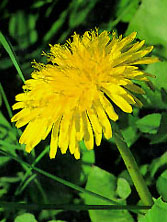Taraxacum officinale
Dandelion leaves
can be blanched in the same way as endive and used in
salads. The roots can also be used in salads or as
vegetables in spring or autumn. Dandelion leaves are very
high in Vitamins A, B, C, and D. The A content in dandelion
leaves is higher than that of carrots. Dandelion flowers
are used to make a wonderful country wine and the roots
provide the best known coffee substitue when dried, chopped
and roasted. I chose the
dandelion to include among my favorite herbs because it is
interesting that a plant everyone thinks of as a weed can be
eaten. I also think that dandelions have many culinary uses,
mostly for the flowers. From
Edible Flowers: Desserts &
Drinks 4
quarts dandelion flowers (remove stem and
sepals) 4
quarts granulated sugar 4
quarts boiling water juice
from 2 lemons juice
from 1 orange 1
yeast cake Add
dandelion flowers to a large stone crock or jar. Cover with
sugar. Add boiling water. When water has cooled
to lukewarm,
add the lemon juice and orange juice. Break up the yeast
cake and add to the liquid. Stir well. Cover loosely and let
stand for 24 hours. Strain through cheesecloth and discard
solids. Return liquid to the crock, loosely cover and let
stand for 3 days. Strain
through several layers of cheesecloth. Return liquid to
crock and allow to ferment. Bottle when all fermentation
action stops. Keep at least 3 to 4 months before
drinking. Makes
1-!/2 gallons of wine. From
Edible Flowers: from garden to
palate 15
dandelion flowers, rinsed in water, but still slightly
moist 1/2
cup all-purpose flour 2
tablespoons butter Dredge
the moist flowers in flour. Heat the butter in a heavy
frying pan. Add flowers and fry
quickly, turning to brown all sides. Serve hot. Close your
eyes and pop one of these crisp goodies into your mouth.
Would you believe it was a dandelion and not a fried
mushroom? Serves
4.
